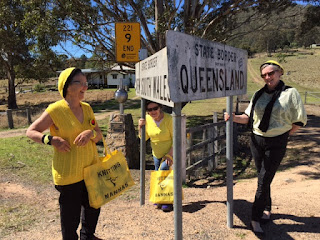 |
| Three of the Grafton Nannas heading north |
Nannas from NSW and Queensland as well as
some from further afield (e.g. Alice Springs) assembled for the conference and
the gasfield tour on the last day. Nanna Lynette was deeply affected by the
experience. Her report of the Nannas’
tour of the Kenya Gasfield (one of a number of gasfields close to Chinchilla)
is below.
* * * * * * *
Nanna Lynette's Report on the Gasfield Tour
I found that although I’d seen many photos and movies of gasfields and had heard people talk about them, nothing prepared me for visiting a gasfield and walking around the infrastructure and hearing the massive amount of noise. The size of the Kenya gasfield and the amount of infrastructure was mind-blowing.
I found that although I’d seen many photos and movies of gasfields and had heard people talk about them, nothing prepared me for visiting a gasfield and walking around the infrastructure and hearing the massive amount of noise. The size of the Kenya gasfield and the amount of infrastructure was mind-blowing.
The
gas from the field is piped to the Kenya processing plant and after processing
is piped to Gladstone. The processing plant, which covers an area of a couple
of acres, consists of three massive metal structures about five storeys
high. The noise coming from this was
horrendous. We were standing about a kilometre away and where we were the noise
was deafening.
 |
| Gas well |
The
next part of the tour was a visit to the State Forest where some of the actual
Kenya gaswells are. Initially they were about a kilometre apart but when
production slowed they drilled other wells in between the existing ones so that
the wells were then 500 metres apart.
Each well sits in a cleared pad of at least a quarter of an acre. This means you’ve a fractured environment
because the ground is bare except for some gravel over it. And each well makes a horrific noise as well.
The
whole area is massively noisy and dusty because of all the clearing.
The cleared pipeline corridors are about 100 metres wide and have been taken over by weeds like fireweed. Along the main pipeline there are vents – high point vents and low point vents about 400 metres apart.
The
high point vents vent raw gas 24 hours a day. Of course this smells. It just goes straight into the atmosphere.
The low point vents expel moisture which is collected in troughs and presumably
evaporates if it doesn’t overflow.
We
spent between four and five hours on the gasfield tour with gas company
officials following us around the whole time.
During
the tour my eyes started stinging and I started to get a headache. Nearly everyone had these symptoms. A couple of people had nose bleeds. I can’t even begin to think of what the
people who are surrounded by gasfields are going through. The side effects of living close to a
gasfield are very real. These unfortunate
people are not making it up.
The
trip and the tour was a good thing to do. I am left feeling really thankful
that we have kept it away from the NSW North Coast.
 |
| Knitting Nannas at the Conference |

